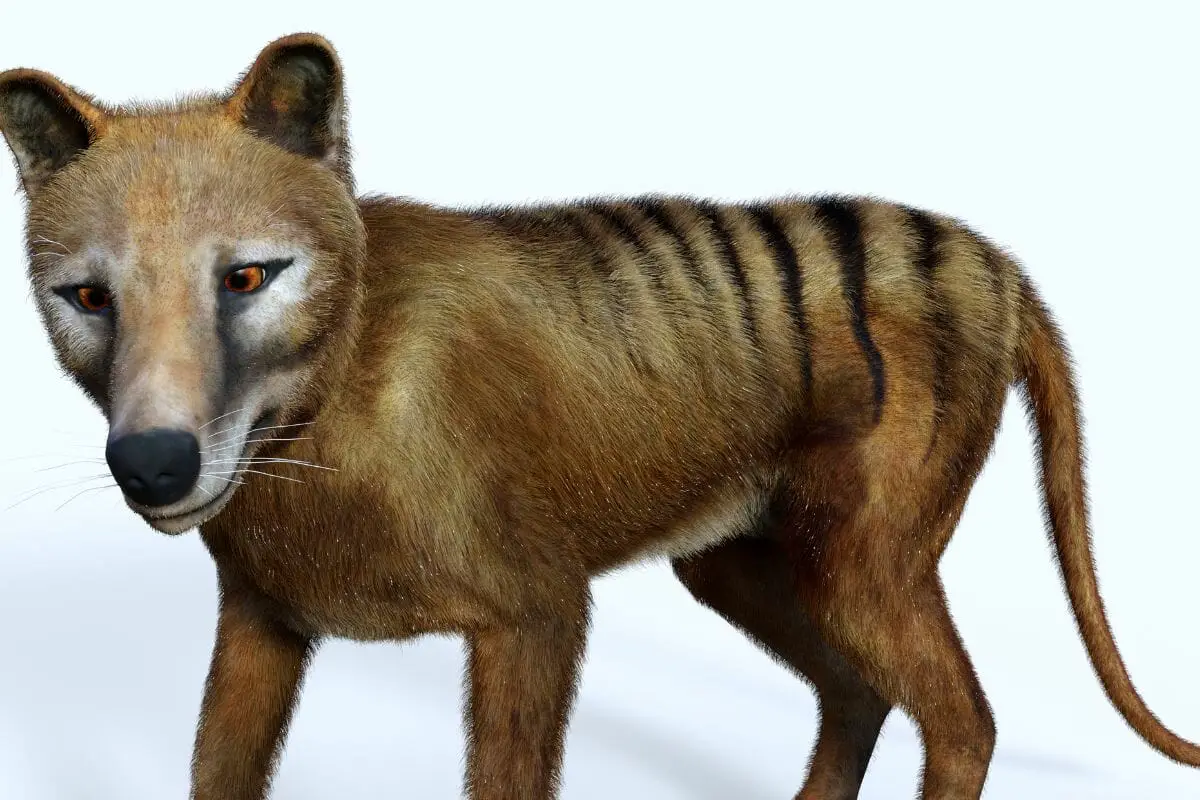The thylacine – otherwise known as the Tasmanian tiger, was a fearsome and widespread creature, which finally faced extinction in the 1960s.

However, there have been numerous people over the years who claim to have encountered this once feared beast in the wilds of Australia and Tasmania – claims that, amongst certain groups, have put its conservation status into doubt.
But what exactly is the truth regarding the Tasmanian tiger, and what evidence is there to support this?
What Was The Thylacine?
The thylacine, or Tasmanian tiger, was a species of marsupial found in Tasmania and parts of Australia.
In appearance, the Tasmanian tiger resembled a large, short-haired dog, but received the name ‘Tasmanian tiger’ due to the distinctive striped pattern along its back and hindquarters.
Like many mammals found in Australia and the surrounding territories, the Tasmanian tiger was a marsupial, which means it carries live young in a pouch until it reaches a suitable age.
Thylacine cubs generally remained in their mothers pouch until the age of three months – after which they would be released from the pouch, but looked after by the mother until they were half adult size.
Were Thylacines Aggressive?
Unfortunately, very little is actually known about the temperament or behaviors of the Tasmanian tiger, and what little information we do have was taken from animals that were in captivity.
This information was also observed during the daytime – which made them unreliable because the thylacine was naturally nocturnal.
As such, what little information we do have regarding their behavior is considered unreliable at best.
The perception they got from these captive animals however was that they were shy and placid – although, as explained, this cannot be taken as a rule of thumb.
Much of the other behavioral information we have surrounding the species has been taken from their close relative – the Tasmanian devil – who are known for their aggressive temperament and voracious appetite.
Although it is important to note that this similarity in behavior is purely speculative.
How Did They Become Extinct?
Unfortunately, there were numerous factors that came together to ensure the extinction of the Tasmanian tiger.
Human Beings
As more and more Europeans relocated to Australia, Tasmania, and the surrounding territories, their presence on the wildlife populations became more distinctive.
With regards to the Tasmanian tiger, they were viewed as dangerous and risks to children and livestock, and as such they were hunted and culled – with landowners paying bounties for their carcasses.
They were also subject to disease and other hazards that widespread human colonization can bring – such as accidental deaths from farming, poaching, and accidents involving horses and automobiles.
Human Expansion
As settlers expanded from the coasts of Australia, New Guinea, and Tasmania, this also led to the destruction of habitats, and the disruption of historic hunting patterns.
As such, the Tasmanian tiger quickly dwindled in numbers.
Dingo Competition
They also bore a lot of similarities to the dingo – another widespread animal throughout Australia and the territories at that time – and as a result they were in direct competition with dingoes for food and shelter.
This, when accompanied by the human threats, led to the Tasmanian tiger becoming extinct on the Australian (see also: Australian Scientists Plan To Resurrect The Extinct Tasmanian Tiger! Could This Be True)and New Guinea mainlands before colonization had even been fully achieved.
Widespread Disease
The mass immigration of humans and new species also led to the rampant spread of disease – something that is thought to have played a huge part on numerous species, of which the Tasmanian tiger was one.
The same effects had been seen on the native, indigenous people of Australia and the surrounding territories, so this theory certainly holds weight with regards to the thylacine.
Have There Been Contemporary Sightings?
According to the Department of Conservation and Land Management, it was reported that between the years of 1936 and 1998, over 203 sightings were reported by members of the public – however none of these supposed sightings were ever corroborated by government officials.

In the 1980s, both a researcher with the Tasmania Parks and Wildlife Service by the name of Hans Naarding, as well as an Aboriginal tracker called Kevin Cameron both reported and supposedly photographed what they believed to be thylacines in the wild – in both 1982 and 1985 respectively.
Likewise, in the mid to late 1990s, there were several reports from a missionary group – as well as a wildlife officer – who claimed to have regularly observed thylacines living in the region they were based – that is, Mount Carstensz in Western New Guinea.
In modern times, government agencies set up elaborate camera traps in the areas where the most sightings were reported, but as of 2022, there have still been no confirmed sightings of thylacines in Australia, Tasmania, or New Guinea.
What Could Have Led To The Sightings?
There are many things that could have led to the sightings of thylacines in these regions, and the same thing has happened at numerous times throughout history.
The Will To Believe
A powerful force amongst human beings is the ‘will to believe’.
This is the same phenomenon that has led to the creation, development, and alleged sightings of numerous cryptids throughout the world – many of which developing from folklore into local legends.
The same could be said to have happened with the Tasmanian tiger, which – while once absolutely real – has since become something a cryptid in its own right, similar to Bigfoot, and Loch Ness monster, and the Mothman of Point Pleasant, West Virginia.
Confusion With Other Species
As mentioned, the Tasmanian tiger was physically similar to both dingoes, and large species of short haired dogs, and as such, there is room for confusion from those claiming to have spotted them.
There is also the fact that the creatures are nocturnal, which instantly distorts any findings and sightings – because the darkness would shroud any detail and create reasonable doubt.
With public knowledge of thylacines, the brain would naturally also make large leaps that aren’t based in fact.
Media Attention Seekers
There is also the fact that, for some people, the attention received from the media and authorities could be a powerful motivator to fabricate sightings of thylacines.
This kind of thing happens with any urban legend, and these situations attract a certain kind of person looking to cash in on the hysteria surrounding such situations.
They are the same people who show up at the scene of accidents to be on the news, or indeed those who claim to have seen mythological cryptids without sufficient proof.
Final Thoughts
And there we have it, everything you need to know about the Tasmanian tiger, and whether or not it can still be found in the wild.
The Tasmanian tiger has become something of an urban legend in Tasmania and Australia, with locals reporting various sightings each year.
While these claims are still unconfirmed, it has spurred on local investigations into whether or not the species could have survived.
So if you go down to the woods today, be sure to be on the lookout for thylacines – you can never be too careful!









